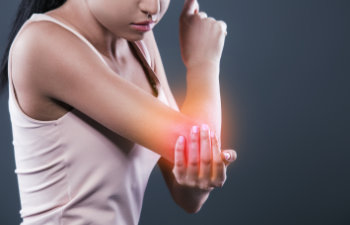
Tennis elbow and golfer’s elbow are both overuse injuries that affect the tendons in the elbow, causing pain and discomfort. Despite their similar names, these conditions differ in terms of the affected tendons, the location of pain and the activities that commonly trigger them. Here are some of the differences in the symptoms between these two elbow conditions.
Causes and Symptoms of Tennis Elbow (Lateral Epicondylitis)
Tennis elbow, or lateral epicondylitis, occurs when the tendons on the outer side of the elbow, specifically the extensor tendons that attach to the lateral epicondyle (a bony bump on the outside of the elbow), become inflamed or damaged. Symptoms include:
- Pain and tenderness on the outside of the elbow, around the lateral epicondyle.
- Weakness in the wrist and forearm.
- Pain worsens when gripping or lifting objects.
- Difficulty with activities that involve wrist extension, such as shaking hands or turning a doorknob.
Despite its name, tennis elbow is not exclusively linked to playing tennis; it can result from any repetitive motion involving the wrist and forearm, such as painting, typing or using hand tools.
Causes and Symptoms of Golfer’s Elbow (Medial Epicondylitis)
Contrary to tennis elbow, golfer’s elbow, or medial epicondylitis, affects the tendons on the inner side of the elbow, particularly the flexor tendons that attach to the medial epicondyle (a bony bump on the inside of the elbow). Symptoms of golfer’s elbow include:
- Pain and tenderness on the inside of the elbow, around the medial epicondyle.
- Weakness in the wrist and hand.
- Pain exacerbated by squeezing or gripping activities.
- Difficulty with activities requiring wrist flexion, like lifting, carrying or swinging a golf club.
This condition is named golfer’s elbow due to its association with the repetitive swinging motions in golf, but it can also develop from activities involving repetitive gripping and wrist flexion, such as throwing, chopping wood, or even typing.
Distinguishing Factors
The primary difference between the two conditions is the location of pain. Tennis elbow causes discomfort on the outer side of the elbow, while golfer’s elbow causes pain on the inner side. Another differentiating factor is how it affects wrist performance. Tennis elbow affects the extensor tendons, responsible for wrist extension, while a golfer’s elbow impacts the flexor tendons, involved in wrist flexion. Tennis elbow is often triggered by activities involving repetitive wrist extension and gripping, while golfer’s elbow results from repetitive wrist flexion and gripping motions.
Treatment Options
Initial treatment for both conditions typically includes rest, ice, anti-inflammatory medications and modifying activities to avoid exacerbating symptoms. Physical therapy, braces and exercises to strengthen the forearm muscles are often recommended. In some cases, corticosteroid injections or platelet-rich plasma (PRP) therapy may be considered for more severe or persistent symptoms. The treatments are very similar for both conditions.
Understanding the differences between tennis elbow and golfer’s elbow is crucial for accurate diagnosis and appropriate treatment. Seeking medical advice from a qualified orthopedic specialist can help in implementing an effective treatment plan and preventing further aggravation of the condition. If you have symptoms of tennis or golfer’s elbow and you are not receiving relief from conservative treatments, come see us at Full Range Spine & Ortho for an evaluation. We have several locations in the greater Los Angeles, CA, area – call the one nearest to you to schedule an appointment.
Posted on behalf of FullRange Spine & Ortho